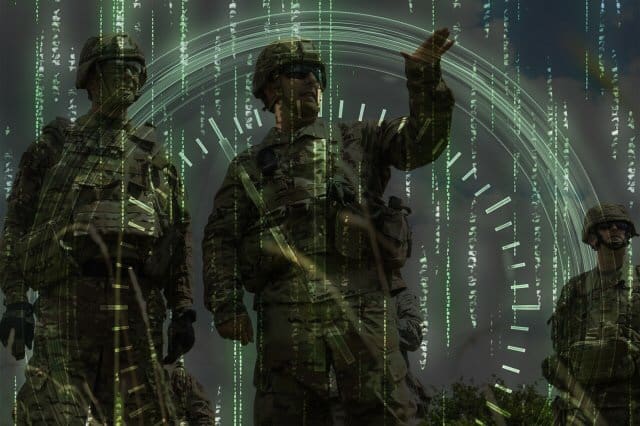FORT MEADE, Md. — In the distant future, teams of Soldiers equipped with high-powered exoskeletons disembark a series of autonomous personnel carriers outside the enemy’s position. Overhead, a small fleet of drones scans the engagement area, giving each Soldier a real-time view of the battlefield through their heads-up display.

As each team moves into position, they hear a series of explosions on the other side of the enemy base. From over 2,000 meters away, the Army’s high-energy precision fires systems have just disabled the enemy’s anti-access and area-denial capabilities.
At the same time, teams of Soldiers use their exoskeleton suits to leap over the perimeter wall to engage the enemy and secure the compound.
This is one scenario of a future operating environment. In reality, it is nearly impossible to predict how the Army will operate and fight in a distant future, said Matt Santaspirt, an Army Futures Command intelligence representative.

To guide the Army in the right direction, the U.S. Army Training and Doctrine Command’s Mad Scientist team functions like a scout on the battlefield, always looking ahead and evaluating ideas to help build the force, he said.
Nested within both Army Futures and Training and Doctrine Commands, the MadSci initiative was created to address opportunities and challenges in the Army’s near-, mid-, and far-term future, said Allison Winer, the team’s deputy director of engagement.
The goal is to maximize the Army’s limited resources and help Soldiers fight and win in a futuristic operational environment, she added.
“The Army only knows what it knows; and [the Army] always talks to itself,” Santaspirt said. “We want to break out of that echo chamber.”
“We are harnessing the intellect of the nation to describe the art of the possible,” he added. “We know that you can’t predict the future, but we’re trying to say, ‘Here is a range of possibilities.’ [The goal] is to be less wrong than our adversary.”
To accomplish this goal, the MadSci team compiles information from a wide range of sources, in support of Army senior leaders’ priorities, Santaspirt said.
These sources include traditional mediums: academia, industry, think tanks, labs, reports, and white papers; to the more nontraditional platforms: crowdsourcing, social media, science fiction, and cinema, to name a few.
Beyond the collection of materials, the MadSci team often organizes themed conferences, bringing communities together to address key Army topics. For example, the team recently conducted the Mad Scientist Disruption and the Future Operational Environment Conference in Austin, Texas.
During the conference, presenters addressed robotics, artificial intelligence and autonomy, the future of space, planetary habitability, and the legal and ethical dilemmas surrounding how these disruptive technologies will impact the future of warfare, specifically in the land and space domains, according to MadSci officials.
“We had somebody come in and talk about robotics and how we can use them in an austere environment,” Santaspirt said, adding there were specific examples of robotics used in Fukushima, Japan.
“The approach is to bring together experts … so we can refine those key ideas, and disrupt [the Army’s] assumptions,” he said.
A week after the event, the team posted some key takeaways from the conference on the Mad Scientist Blog. The MadSci blog and other social media platforms are often used as a crowdsourcing tool to help poll an audience or generate conversation about key Army topics, Winer said.
Some of the conference findings included: a need to set left and right boundaries for artificial intelligence and autonomy, increased crowding of assets in space will cause operational challenges, and fake news coupled with hyper-connectivity is changing the nature of information warfare.
Additionally, the MadSci team organizes science fiction writing competitions to help determine possible futures for crucial Army programs, Winer said. For years, science fiction has depicted worlds that are both logically possible, but functionally different than current society.
“Science fiction is used as a kind of forecasting to see what possible futures might look like,” she said. “Aside from being just plain-on cool, it gives the Army a way to use storytelling, historical analysis, and outsourcing to write about the realm of the possible. And it is an effective tool for a lot of businesses and other leaders in industry to try.”
Through their research and continual online engagements, the MadSci team creates a range of possibilities, then later presents their findings to Army senior leaders and key decision makers, Santaspirt said.
“It is a different way of thinking,” Santaspirt said. “If [the Army] can get that out there and start meeting the right people, make certain decisions or investments, or get people thinking in a different way … you might see what we’ve discovered — as it comes to light down the road.”
Mad Scientist Initiative Website
Mad Scientist Initiative videos
By Devon L. Suits, Army News Service
Photos by Peggy Frierson & Mad Science Initiative


Sounds like a movie instead of reality.
This kind of thing pisses me off. Why not dig a hole and put millions of hard earned tax money in it. People need to be held accountable for idiot stuff like this, freaking really pisses me of.
Do we really stand a chance in he long run when we can’t even have logical thoughts ? Our country is officially stupid and it is embarrassing .
Yeah, they burned through lots of $ for Nett Warrior and then said, ah hell, lets just buy some smart phones.
The german army buys 16ooo galaxy s8 without Internet…
for each some hundert bucks/€
Why???
No Internet garanties more ah no total security!
We,Germans are so good 😉
We bought the future,yippekayeh!
And Samsung will not provide forever security-updates for the S8s
Sci Fi predictions in the past have almost always proved to be way off base. Not sure human nature can be changed, with regards for the ability to predict future trends.
Sci Fi is not predictive – it’s usually an examination of the POSSIBILITIES. And that’s how quality science fiction can be best used. To examine and wrestle with ideas and concepts. To go “oh shit, I never thought of XYZ in quite that way.”